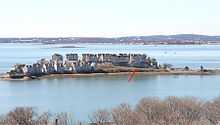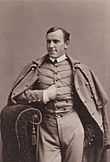Fort Duvall


Fort Duvall[1] was a Coast Artillery fort, part of the defenses of Boston Harbor, in Massachusetts. What was then called Hog Island was acquired by the U.S. government in 1917, and the fort was constructed in the early 1920s. It had only one gun battery, Battery Long, but it mounted the largest caliber weapons in the entire harbor defense system: a pair of 16-inch guns.
In 1922 the fort was named for Major General William Penn Duvall (1847-1920). A graduate of West Point, Duvall was born in Maryland, was a principal assistant to the Army Chief of Artillery, and served two tours of duty in the Philippines (the second as commander of all Army troops there), where he distinguished himself for his even-handed administration of the islands.[2]


The long range guns of Fort Duvall could cover an arc running roughly from Gloucester in the north down to Plymouth in the south, and extending well out to sea. Hidden behind the bluff at Point Allerton, the fort could not be observed from the sea. Fire for the guns was directed and observed from the tall fire control tower at Point Allerton, which survives to the present (2010) under private ownership.
At the time of Battery Long's construction, the next largest guns were the barbette-mounted 12-inch guns of Battery Gardner at Fort Ruckman in Nahant, MA. Later, two more 16-inch guns were added in Nahant and made up Battery Murphy. A third pair of 16-inch guns was planned for Fort Dawes on Deer Island, but after the emplacements were constructed at the outset of WW2, the tubes for this battery were never delivered. Instead, in the early 1940s, many of the longer-range 10-inch and 12-inch batteries of the harbor defenses (including the major batteries at Fort Revere in Hull, just north across the water from Fort Duvall), plus all of their 12-inch coast defense mortars, were decommissioned and scrapped.
References
- ↑ Sometimes the Army spelled the name of this fort incorrectly as "Duval." Indeed, West Point even mis-spelled Duvall's name on his class photograph.
- ↑ This information comes from Duvall's obituary in the "Fifty-first Annual Report of the Association of Graduates of the United States Military Academy [USMA] at West Point, New York June 14th, 1920, p. 136. Document provided as a .pdf by the Archives of the Library, USMA, August, 2010.
Coordinates: 42°18′00.36″N 70°53′45.17″W / 42.3001000°N 70.8958806°W